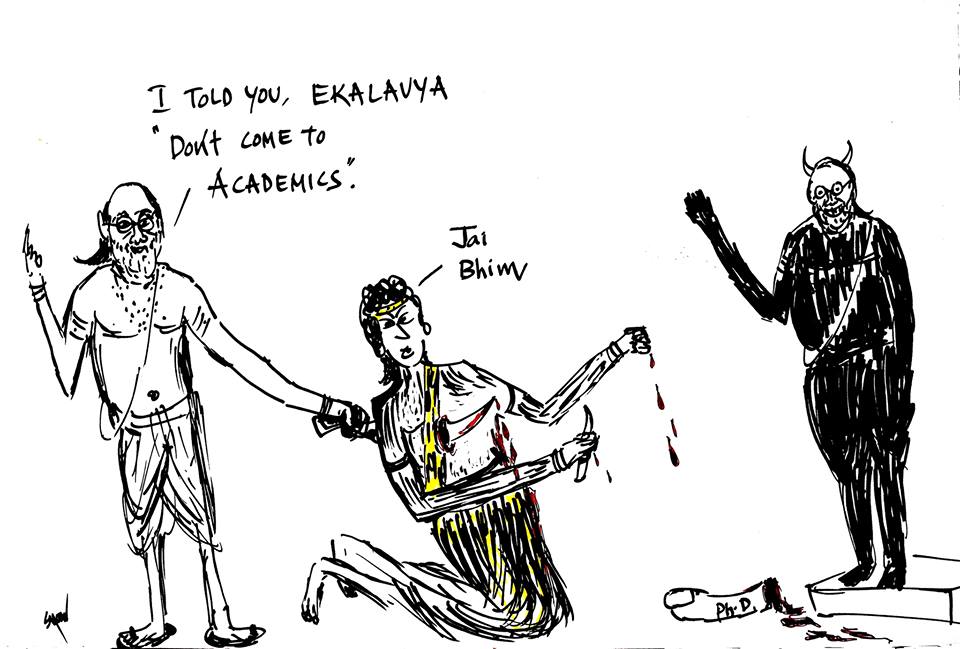Bobby Kunhu
“The Mismeasure of Man treats one particular form of quantified claim about the ranking of human groups: the argument that intelligence can be meaningfully abstracted as a single number capable of ranking all people on a linear scale of intrinsic and unalterable mental worth.” – Stephen Jay Gould, “Mismeasure of Man”

I would have thrown the Print list of intellectuals into my mental trash can except for the fact that it once again reiterates what I call the Dronacharya complex in the production and control of knowledge in South Asia. The most famous and supposedly the best talent among Drona’s students was Arjuna – the central question is how did Arjuna achieve this supposed meritorious status? By Drona unfairly demanding the thumb as a fee from a self taught Adivasi youngster Ekalavya – who despite his forced disability went on to prove himself to be a true talent and a hero. This epitomizes how caste and merit work – a totally male narrative with the real life Arjunas being much bigger wimps and robbers of other people’s efforts. The Print list uses precisely this complex to create an elite Savarna old boys club – who nominate their heirs with the Print as their pioneering patron!
Look at how the list starts off reinforcing its roots in Brahminical epistemology –
“India has a rich and ancient tradition of producing such thinkers, teachers and philosophers who have contributed to the creation of new schools of thought that have travelled and established themselves far beyond Indian shores too. They have also passed on their learnings and discoveries to successive generations to preserve, innovate upon and further.
But who are the next generation of Indian intellectuals in the modern times we inhabit? The next Ramachandra Guha, the next Arvind Panagariya, the next Ashok Gulati, the next Raghuram Rajan, the next Makarand Paranjape, or the next Shashi Tharoor?”
An apologetic problematic of this list was conveniently pointed out by the Print itself in a rebuttal by Apoorvanand – which in many ways also legitimized the list for the main issues of the list are obvious – the lack of diversity – be it disciplinary, linguistic, gender, caste, disability, sexuality, religious and so on. But what the rebuttal failed to say was the basic problematic and that is methodology or the Dronacharya complex. Because the Print does not feel it necessary to tell the readers how it decided on who India’s top intellectuals are, but just forces it on them and what parameters were given to them for the nomination purpose.
Since the readers are left to guess the methodology of curation (if we should dignify this abomination with the word) of the list – we will have to take a glance at the curators themselves – from their names – I guess four women and two men with very savarna surnames. So how did they put together this list of people who are politically, ideologically and work wise so different from each other? My suspicion is that it was based purely on what the location of the curators exposed them to – and given their privilege, I do not see them to be ideologically or politically rooted. The reason for this suspicion is that most of the nominators are like a list of page 3 intellectuals – with discredited and often contested intellectual credentials, but loud and abrasive, wearing their caste and often maleness on their sleeves.
Since I don’t have the time and patience to subject RTI readers to a lengthy analysis of each one of the nominators, I will limit myself to the most glaring samples among the nominators whose only intellectual contribution in life has been self promotion…
1. Ashis Nandy – a sociologist and psychologists whose methods and analysis apart is known for the privilege with which he got away saying “It is a fact that most of the corrupt come from OBCs and Scheduled Castes and now increasingly the Scheduled Tribes. I will give an example. One of the states with the least amount of corruption is state of West Bengal when the CPI(M) was there. And I must draw attention to the fact that in the last 100 years, nobody from OBC, SC and ST has come anywhere near to power. It is an absolutely clean state” at the Jaipur Literary Festival. He has always been a darling of both the savarna media and academia, so much so that his casteism was acquitted generously by this very media and academia in full public glare. So he is not a surprise entry into any such list. But the question is with his casteism, what credibility does his nomination have as P. S. Krishnan rightly exposes his Dronacharya syndrome (complex)?
2. Nandan Nilekani is an interesting odd man (given that there are only men in the list) in the list and can only be the result of a shallow urban understanding of what intellectualism is. If Nilekani, why not Ambani brothers or Sanjaya Baru beats me completely.
3. With all due respects to N. R. Madhava Menon who was my teacher, anybody who has read him would tell you that given the entrenched prejudices and closed mindedness of his writings, the last thing that he can be called is an intellectual. Yes, he was a visionary institution builder, a disciplinarian and marketer that he transformed the status of legal education in India – but also made it elitist and unaffordable in the process. His prejudices come out openly in his reasons for nominating Abhinav Chandrachud for belonging to a distinguished legal family — his grandfather Yeshwant being the longest-serving Chief Justice of India, while dad Dhananjaya being a sitting Supreme Court judge.
4. Most historians worth their salt across ideologies would denounce their profession for including this man’s quirky, loud and self obsessed sense of method as history. The only reason he can be in any list of intellectuals is that he knows the right places to present and promote himself. His male chauvinistic slanging match with Arundhati Roy in the Frontline was well documented.
5. Shashi Tharoor ought to be in this kind of a list, not only for his achievements, but also for his flamboyance, after all it does send a very deep message just after he has made his intellectual credentials clear with his floccinaucinihilipilification about abstract notions of constitutional principle having to pass the test of societal acceptance before women can enter Sabarimala. The Dronacharya complex in his case is the most obvious having nominated his inconsequential former chief of staff as the next generation intellectual.
Upendra Baxi, the only person in the list whose intellectual credentials I am comfortable with also ended up disappointing given that while he nominated a number of women, all his nominations were from privileged communities. This exception actually demonstrates the validity of the argument that savarnas regardless of their stated ideological positions or bonafides can never really connect with Dalit Bahujan expressions. I think a cue can be got from the pathetic apology that has been appended at the end of the list as to why there are no woman nominators. Because, women – intellectuals or otherwise – wised up to being part of such an insidious and subversive list! It is also interesting to see that Kalpana Kannabiran is the only person from the list who critiqued (as far as I have seen) the list and retained credibility!
The other very important thing that needs to be critiqued about both the nominators and the nominated apart from their savarna malehood is that majority of the work for which they are being promoted belongs to the realm of propagation of classist and casteist framework of knowledge and action – very often camouflaging themselves as experts – the best examples would be Shiv Visvanathan and Dipankar Gupta. They conveniently lend themselves to discourses that often run counter to the aspirations and political assertions of Dalit Bahujan communities!
Notwithstanding the important criticism that the list pretends no other language apart from English has been accounted for in the list, it has to be asserted that English has been an important language of emancipation for many Dalit Bahujan communities particularly from the everyday casteism of Indic languages. So lot of Dalit Bahujan political assertions are framed in English! In many ways the list and the nominators are appropriating English language as well as a savarna language – by excluding the rich Dalit Bahujan intellectual work that is available in English across ideological spectrum – be it K. Satyanarayana, Kancha Ilaiah, Chandrabhan Prasad, Anand Teltumbde, Sukhadeo Thorat, Bhalchandra Mungekar, Krupakar Madiga, Ruth Manorama and the list is endless. The act of not finding a single Dalit Bahujan Muslim voice has to be seen as a politically casteist act that it is of trying to appropriate English as a savarna language!
It is fascinating that a simple Google search throws up the levels of proximity between the nominator and the nominated – a caste kinship that is behind this entire exercise. Any editor worth her salt would know that unlike academia, law, medicine, arts, humanities etc. intellectualism is a perception and cannot be calibrated – and attempts at such calibration can only be propaganda at best and fascism at worst. It is useful that Govindacharya remains RSS intellectual, Shashi Tharoor, the Congress intellectual, Prabhat Patnaik, the CPM intellectual and Mayawati or Shepherd, my intellectual – so we know where we stand with respect to each other and the hegemonies that we have to battle.
Most importantly there are no more Ekalavyas who would cut their thumbs for the ambition of some dubious Drona’s unworthy disciple!
Like Walter Lippman said: “self-deception as the preliminary to public deception is almost automatic.”
~~~
Bobby Kunhu is a lawyer, researcher and writer.
Cartoon by Unnamati Syamasundar.










